Contents
- 1. Clifton Beaches
- 2. Camps Bay
- 3. Beta Beach at Bakoven
- 4. Llandudno Beach
- 5. Boulders Beach
- 6. Muizenberg
- 7. Blouberg
- 8. Hout Bay Beach
- 9. Mouille Point Beach
- 10. Long Beach
- 11. Oudekraal Beach
- 12. St. James Beach
- 13. Glen Beach
- 14. Queens Beach
- Map of Beaches in Cape Town
- Cape Town, South Africa – Climate Chart
Author Becca Blond has written guidebooks on South Africa. She spends as much time as possible in Cape Town and considers the city a second home.
Located on a peninsula, Cape Town is surrounded by stunning beaches. These beaches boast not only long stretches of white-gold sand, they are also set to a gorgeous natural backdrop of towering mountains and cliffs. There is no question, the beaches around Cape Town are some of South Africa’s best, but even if the water glitters a brilliant aquamarine and turquoise in spots, don’t expect it to be warm.
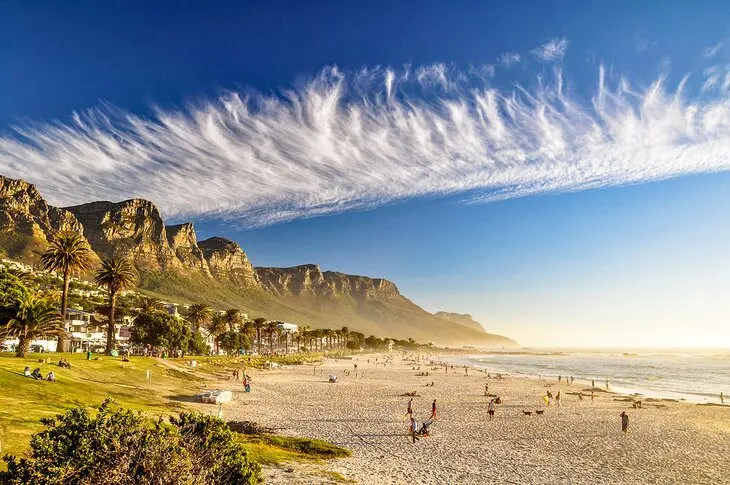
The beaches on the Atlantic Coastline, including famous Camps Bay and Clifton Beaches, are never warm because the current here comes straight from Antarctica. But that doesn’t keep people from flocking to them for sunbathing, walking, or quick toe dips in the frigid sea. There is good surf around here, but you’ll need a full-body wetsuit year-round.
On the False Bay side of the peninsula, the water is marginally warmer, and people do swim and surf, although often still wearing full-body suits. But even though these might not be the kind of beaches you spend hours floating around in the sea, they are some of the world’s most beautiful and well worth a visit. Find out more with our list of the best beaches in Cape Town.
1. Clifton Beaches

Highlights: Cape Town’s trendiest beaches, each is set in a cove protected from the wind by boulders
Made up of four absolutely gorgeous white-sand beaches backed by smooth granite boulders known as the Twelve Apostles, the beaches at Clifton are Cape Town’s most tony and trendy.
Some of the city’s most expensive real estate overlooks these beaches, which are accessed by steep sets of stairs from the main road about six kilometers from the city center. Each is set in its own cove and protected from wind by giant boulders, making them ideal for sunbathing.
Named for the order in which they are encountered coming from Cape Town, each beach has its own distinct vibe. Head to First Beach if you want some peace and quiet. It is usually less crowded. It is also off-leash dog-friendly, should you be traveling with a pup. This beach has decent surf under the right conditions and attracts body-boarders on hot summer days.
Second Beach attracts a younger crowd and has an active summer volleyball scene.
Third Beach is Clifton’s gay beach but is open to everyone. The beach is often less crowded than the others and has a buzzy atmosphere.
Fourth Beach is the largest and most trendy of the Clifton beaches and attracts a mix of families, groups of friends, and couples. It also boasts coveted Blue Flag status, which is awarded for clean water, safety, and environmental management. It also has views of Cape Town’s second most famous peak, Lion’s Head.
2. Camps Bay
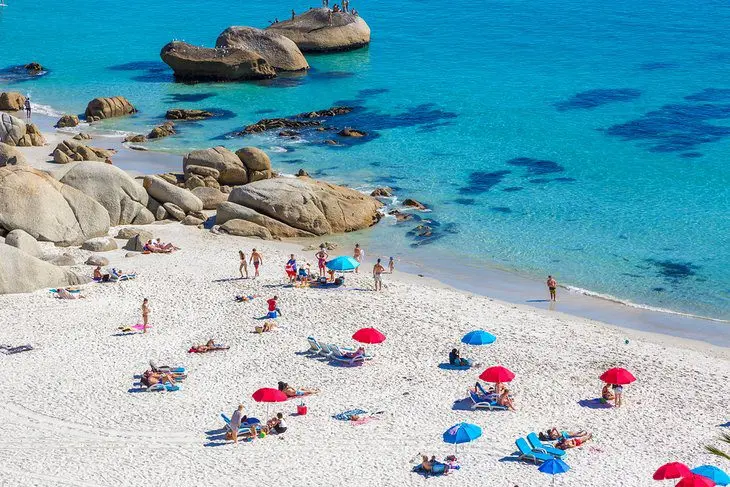
Highlights: Amazing views of the Twelve Apostles and Lion’s Head; it is where to hang out on summer weekends
Vying with Clifton for Cape Town’s top beach status is Camps Bay. The only reason we placed it second here is that Clifton offers a little more protection from Cape Town’s infamous wind. Located just around the corner from Clifton, Camps Bay is also a Blue Flag beach.
The beach is long and wide and easy to access, although parking can be difficult on summer weekends when it gets very crowded — take public transport or an Uber to not have to worry about finding a spot to park. It is just across the road from a string of restaurants and cafés, making it easy to grab lunch between sunbathing sessions. Camps Bay also has great views of the Twelve Apostles and Lion’s Head.
If you want to stay in Camps Bay, check out South Beach Camps Bay . The luxe boutique hotel is one of our favorites in all of South Africa. Inspired by the Miami art scene, it features contemporary white-on-white decor in its 19 suites, which all face the sea and come with either balconies or private patio areas. Make sure to check out the art around the property. It is all original by well-known South African artist Lionel Smit.
3. Beta Beach at Bakoven
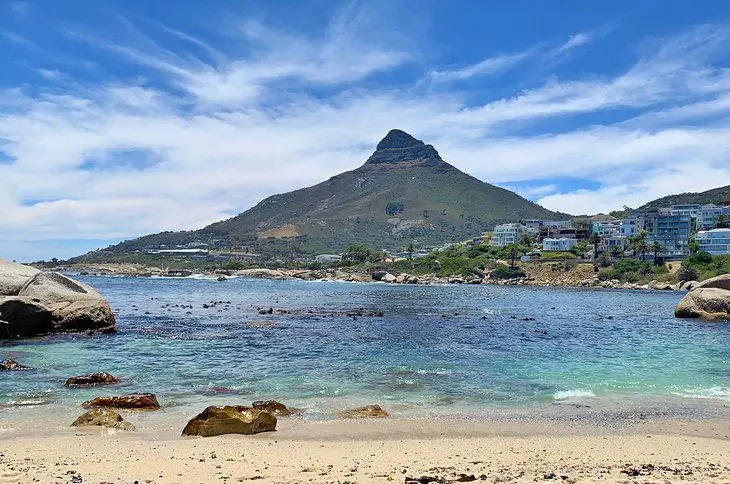
Highlights: A local favorite beach for its Lion’s Head views and amazing sunsets
Just about a kilometer down the road from Camps Bay, Beta Beach at Bakoven is quieter than Camps Bay and has calm blue seas set against white sand — the water here is usually wave-less but it is still on the Atlantic coastline, so expect it to be mind-numbingly chilly.
This is a favorite beach with locals — the views of Lion’s Head are mesmerizing — and this area is often used for photo shoots. The sunsets at Beta Beach are also well worth experiencing. Most nights, you can expect a fiery tableau of shifting colors as the sun appears to set right into the ocean in front of you.
4. Llandudno Beach

Highlights: Less crowded than other Cape Town beaches; great sunsets; perfect for beach picnics
Just about 20 kilometers south of Cape Town heading towards Hout Bay, Llandudno Beach is where the locals go to escape the crowds at Clifton and Camps Bay. Located down a narrow windy road off the highway in a ritzy hillside neighborhood, it is a favorite for beach picnics; sunbathing; and, if you can brave the cold Atlantic temperatures, body boarding and surfing.
Like other Atlantic coastline beaches, its westerly location means it gets gorgeous nightly sunsets.
There are no restaurants or shops around this beach, so you’ll need to pack in everything you want to use for the day with you, including chairs, umbrellas, and snacks. The beach itself is wide and set in a cove filled with soft sand that is good for building sandcastles.
Llandudno is popular with families, groups of friends, and couples alike. On summer weekends, it can get crowded, so arrive early for a good spot.
5. Boulders Beach
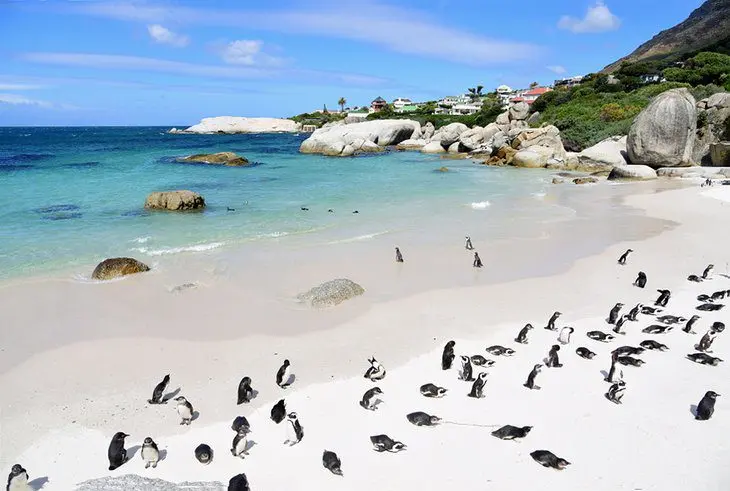
Highlight: The penguins! Boulders Beach is home to a large colony of African penguins
If you’re a fan of penguins, head to Boulders Beach. About 40 kilometers south of Cape Town near the pretty village of Simon’s Town on the way to the Cape Point Nature Reserve, this beach is home to a large colony of endangered African penguins. The beach is set between large granite boulders on the False Bay coastline, so the water is slightly warmer here if you want to swim.
The penguins are highly entertaining as they strut between the sand and sea. Although they are cute, please remember they are still wild animals, and getting up close to one for a selfie is probably not the best idea.
6. Muizenberg
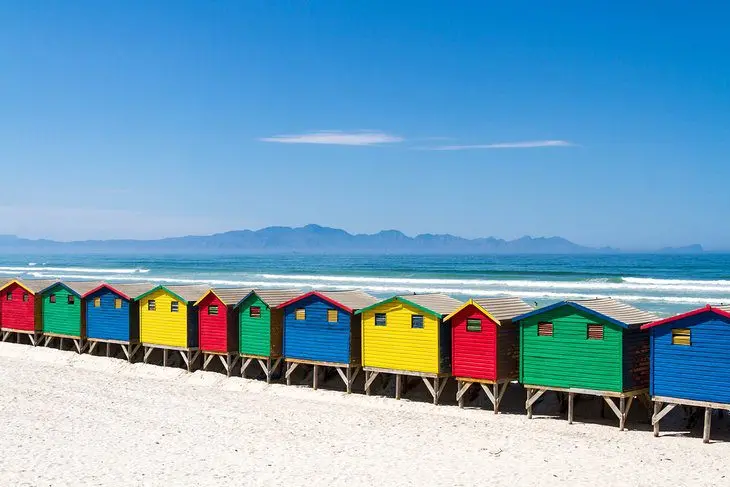
Highlights: One of Cape Town’s best surf beaches; the brightly colored huts are super photogenic
One of the best surf beaches around Cape Town, Muizenberg is on the False Bay side (it is about 25 kilometers from downtown), so the water is slightly warmer.
The waves at this Blue Flag beach are pretty tame and great for beginner surfers, and there are a number of companies that offer surf lessons and board and wetsuit rentals in the town behind the beach. Muizenberg is also popular with families, and a portion of the beach is patrolled by life guards in summer.
If you’ve ever seen photos of brightly colored huts set on a beach in South Africa, you’ve been looking at pics of Muizenberg. Known as bathing boxes, they are throwbacks to the Victorian era, when women would use them to change into chin-to-ankle bathing suits in privacy. Today, they are a favorite for Instagram photos and also appear in a number of commercial shoots.
7. Blouberg

Highlights: One of the world’s top areas for kitesurfing; it hosts international annual competitions
About 20 kilometers to the north of Cape Town’s city center on the Atlantic coast, Blouberg comprises a few different beaches, including Dolphin Beach, Small Bay, and Big Bay. If you are into kitesurfing, head to Big Bay, which is one of the top spots in the world for the sport. The beach also hosts an international kitesurfing competition annually.
Small Bay is where to head for fewer crowds. It attracts a lot of families, and kids will love making sand castles in the soft sand here.
This area is also perfect for snapping a postcard-worthy photo of one of Cape Town’s most famous attractions, Table Mountain. The city is built around the 6,000-foot-high table-shaped mountain in its middle, and from Blouberg, you get an unobstructed view. The west coast location also makes for stunning sun-setting-into-the-ocean photographs.
8. Hout Bay Beach

Highlight: Getting here via the stunning Chapman’s Peak Drive, one of South Africa’s most gorgeous drives
Hout Bay is a suburb of Cape Town that is best reached by driving the jaw-dropping Chapman’s Peak Drive. The 7.2-kilometer road runs along the Atlantic coastline between Hout Bay and Noordhoek and is one of the most stunning ocean-facing drives on the planet — if the scenery looks familiar, you’ve probably seen it in a car commercial.
The beach sits between the cliffs of Chapman’s Peak itself and the Hout Bay Harbour and is almost a kilometer long and backed by sand dunes. The beach here is quite wide at points and is split in the middle by a small river that you can easily cross. Hout Bay Beach is popular with families and is also dog-friendly. There is a stable nearby, and you’ll often see people horseback riding along the beach.
After a day playing in the sand, you can grab a bite to eat at one of the restaurants in the town of Hout Bay before heading back to Cape Town. The Lookout Hout Bay is one popular dining option.
9. Mouille Point Beach
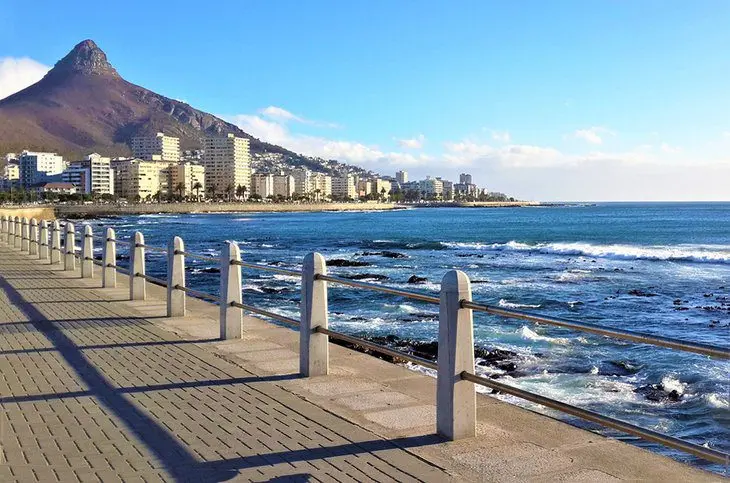
Highlights: Taking an afternoon walk along the promenade running parallel to the beach; sunsets are also stunning
Located between the city center and Camps Bay, Mouille Point Beach is perfect for an afternoon walk. This urban beach is also known as Granger Bay and is easy to access, with plentiful parking (something that is harder to find around Camps Bay or Clifton).
There are benches along the promenade that runs parallel to the sand, and you can see Robben Island, where Nelson Mandela was incarcerated, in the distance from here.
If you’re traveling with the kids, they’ll love playing in the tidal rock pools at Mouille Point. A number of restaurants and cafés are also scattered along the promenade, and sunsets here are stellar. If you like to run, this is a good spot to do so.
10. Long Beach
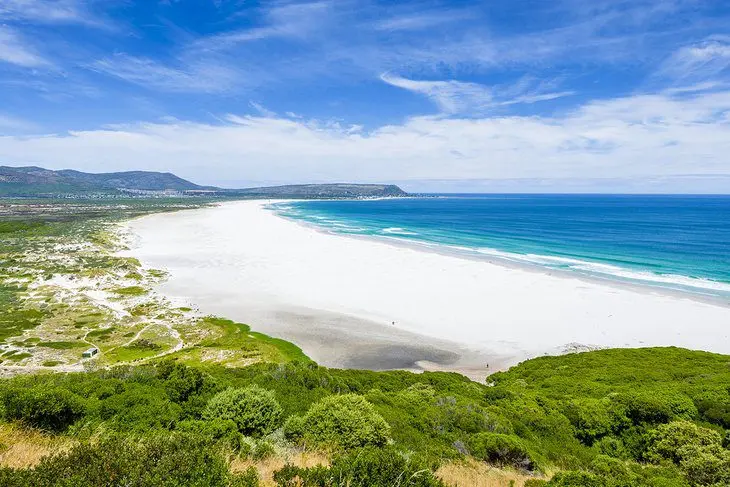
Highlights: Taking long walks on its powdery white sand; the beach runs for eight kilometers
Cape Town’s longest beach, aptly named Long Beach, is south of the city center in the suburb of Kommetjie on the Atlantic coast. At eight kilometers long, it is a favorite with active types and perfect for long walks on the powdery white sand.
It is also dog friendly, and you’ll see plenty of happy pups running along the beach or swimming in the sea (which is very cold, however). The surfing here is also top-notch, although you’ll definitely need a wetsuit. Bodyboarding is also popular at Long Beach. If you enjoy a good sunset, you’ll find daily explosions of color at dusk.
11. Oudekraal Beach

Highlights: A hidden beach cove strewn with small boulders; decent offshore snorkeling
Located inside Table Mountain National Park (so you’ll have to pay an entrance fee to access it), Oudekraal is worth the trek. The hidden beach cove has BBQ facilities by the sand, and locals like to come here for a fire and a braai (the South African word for BBQ). The white-sand beach is also strewn with small boulders and shallow tidal pools.
If you have a wetsuit and are brave enough to handle the cold Atlantic water, there is decent snorkeling just offshore. Don’t expect tropical coral, but you will see colorful kelp and a few different kinds of fish. Advanced divers can explore a unique boulder cave site as well.
12. St. James Beach
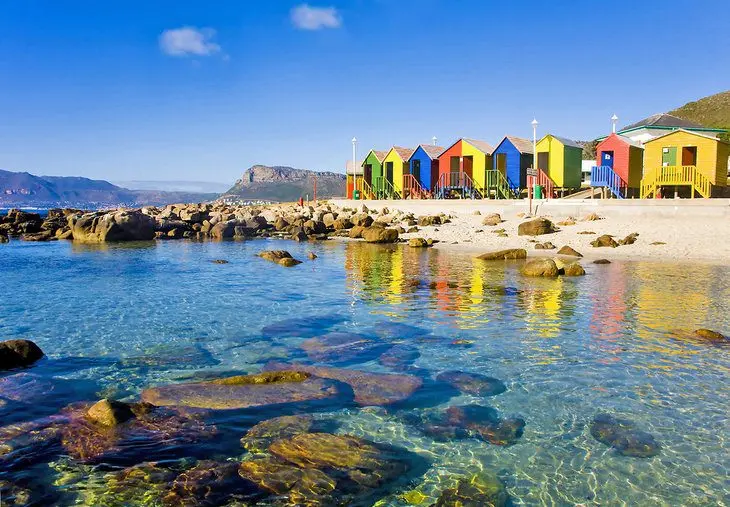
Highlights: A top choice for families; it has shallow rock pools to splash in
It is about a 15-minute walk from the shops and restaurants at Kalk Bay to St. James Beach on the False Bay seafront. The small beach is a perfect pick for families, as there are shallow rock pools for the kids to splash around in that are warmer than the open ocean. The beach is also sheltered from wind and big waves.
Like Muizenberg, St. James also has a picture-perfect row of multi-colored wooden beach huts that make popular social media photo shoot backdrops. Kalk Bay is located about 30 minutes’ drive from downtown Cape Town and is a historic harbor and small town that is a popular local day-trip destination.
13. Glen Beach
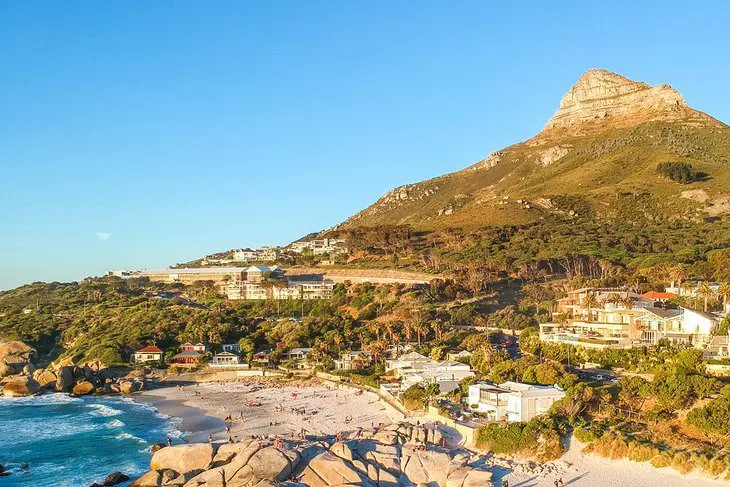
Highlights: Twelve Apostles views; fewer crowds than adjacent Camps Bay Beach
Neighboring Camps Bay Beach, Glen Beach is less crowded and laid-back but still offers visitors a chance to sunbathe and socialize with a stunning Twelve Apostles mountain backdrop. Although you won’t have this beach to yourself on a sunny summer day, it does see less people than its glamorous sister beach located about 10 minutes by foot away.
With sand dunes and granite boulders protecting it, Glen Beach also provides a refuge from Cape Town’s often forceful wind gusts. There is a “wedgie right” surf break here that is a favorite with locals in season, and the beach is also popular with dog parents, who come to let their pups play. In summer, you’ll find strolling vendors selling refreshments, from ice cream to cold sodas.
Glen Beach is not well signposted. Look for it on the side of Victoria Road before turning left to Camps Bay if taking the road down from Kloof Nek. You’ll see parking spaces and two sets of steps on both sides of the beach.
14. Queens Beach
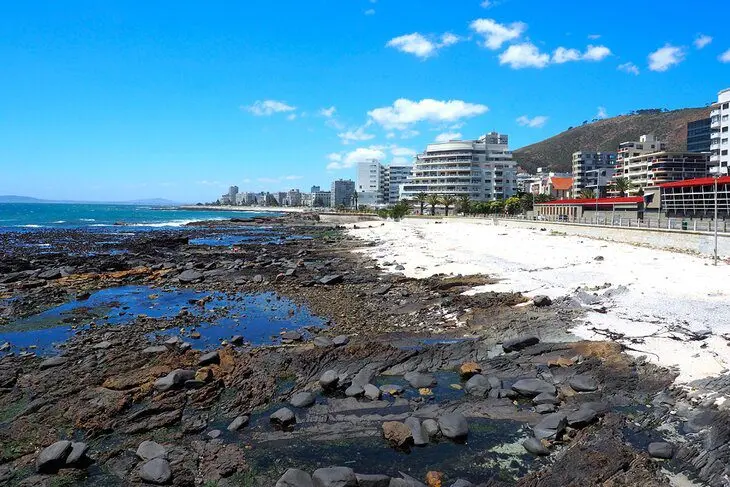
Highlights: Usually uncrowded, a great central location in the Sea Point neighborhood
In the Sea Point neighborhood, Queens Beach is located just far enough away from the well-known Sea Point Promenade to feel worlds apart. Overlooked by many beachgoers, including locals, it is usually not crowded even during the summer months.
Just a five-minute walk from the Sea Point public swimming pool, Queens Beach is also sheltered from the wind, so it’s a great place to sunbathe or have a picnic on a summer day. If you like to ride waves, the locals call the surf break here the “big and mushy.”
There are also some natural rock pools, with starfish and other marine life, that kids can check out. Visit in the late afternoon and stay for sunset. These are usually quite spectacular.
Map of Beaches in Cape Town
Cape Town, South Africa – Climate Chart
| Average minimum and maximum temperatures for Cape Town, South Africa in °C | |||||||||||
| J | F | M | A | M | J | J | A | S | O | N | D |
| 25 17 | 26 17 | 24 16 | 22 13 | 19 11 | 18 9 | 17 8 | 17 9 | 18 11 | 21 12 | 22 14 | 24 16 |
| PlanetWare.com | |||||||||||
| Average monthly precipitation totals for Cape Town, South Africa in mm. | |||||||||||
| 15 | 15 | 20 | 41 | 69 | 94 | 84 | 76 | 41 | 3 | 0 | 18 |
| Average minimum and maximum temperatures for Cape Town, South Africa in °F | |||||||||||
| J | F | M | A | M | J | J | A | S | O | N | D |
| 77 63 | 78 63 | 76 60 | 72 56 | 67 52 | 64 48 | 62 47 | 63 48 | 65 51 | 69 54 | 72 58 | 75 61 |
| PlanetWare.com | |||||||||||
| Average monthly precipitation totals for Cape Town, South Africa in inches. | |||||||||||
| 0.6 | 0.6 | 0.8 | 1.6 | 2.7 | 3.7 | 3.3 | 3.0 | 1.6 | 0.1 | 0 | 0.7 |
The best time to go to the beach in Cape Town is during the summer months of December, January, and February. The temperatures are warmest during these months, both air and sea. Note that although the ocean sparkles turquoise, it is far from tropical.
Thanks to a current that comes straight from Antarctica, Cape Town’s water temperatures are frigid year-round, especially on the Atlantic Ocean side. Beaches on the Indian Ocean, like Muizenberg, are slightly warmer, but still far from warm, and you’ll want to wear a bodysuit year-round when surfing.
June and July are the coldest and rainiest months of the year. You still get lots of sunny days, but it’s not usually warm enough to sunbathe. If you are visiting to surf, winter brings the most consistent waves. In August, the winter rains are phased out and this is the best time to spot southern right and humpback whales calving in the water just offshore.










